
Pac-Man, originally called Puck Man in Japan, is a 1980 maze action video game developed and released by Namco for arcades. In North America, the game was released by Midway Manufacturing as part of its licensing agreement with Namco America. The player controls Pac-Man, who must eat all the dots inside an enclosed maze while avoiding four colored ghosts. Eating large flashing dots called "Power Pellets" causes the ghosts to temporarily turn blue, allowing Pac-Man to eat them for bonus points.

Ms. Pac-Man is a 1982 maze arcade video game developed by General Computer Corporation and published by Midway. It is a spin-off sequel to Pac-Man (1980) and the first entry in the series to not be made by Namco. Controlling the title character, Pac-Man's wife, the player is tasked with eating all of the pellets in an enclosed maze while avoiding four colored ghosts. Eating the larger "power pellets" lets the player eat the ghosts, who turn blue and flee.
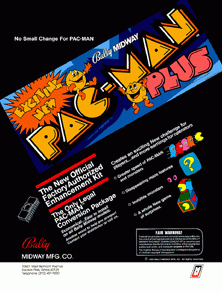
Pac-Man Plus is an arcade game that was released by Bally Midway in 1983. It is part of the Pac-Man series of games.

Pac-Land is a 1984 side-scrolling arcade platform game developed and released by Namco. It was distributed in North America by Bally Midway, and in Europe by Atari Games. Controlling Pac-Man, the player must make it to the end of each stage to return a lost fairy back to its home in Fairyland. Pac-Man will need to avoid obstacles, such as falling logs and water-spewing fire hydrants, alongside his enemies, the Ghost Gang. Eating large flashing Power Pellets will cause the ghosts to turn blue, allowing Pac-Man to eat them for points.

Super Pac-Man is a 1982 maze chase arcade game developed and published by Namco. It was distributed in North America by Midway, and is Namco's take on a sequel to the original Pac-Man; Midway had previously released Ms. Pac-Man, which Namco had little involvement with. Toru Iwatani returns as designer.

Pac-Man World 2 is a video game by Namco USA for the Xbox, GameCube, and PlayStation 2, released in 2002. A version of the game for Microsoft Windows was released in 2004, and an isometric sidescroller was made for the Game Boy Advance in 2005. The game is a sequel to Pac-Man World (1999). The game is a platform game, where the player controls Pac-Man in a 3D platforming environment, through six worlds. In 2005, a sequel, Pac-Man World 3, was released.

Pac-Man 2: The New Adventures, known in Japan as Hello! Pac-Man, is a 1994 side-scrolling point-and-click adventure game in the Pac-Man series developed and published by Namco. Instead of being a maze game like the majority of its predecessors, Pac-Man 2 incorporates light point-and-click adventure game elements. The game borrows its structure and certain elements from Pac-Land, and also appears to contain certain elements from the animated series, such as Pac-Man's family and a main villain commanding the ghosts.
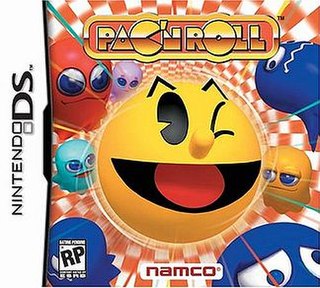
Pac 'n Roll is a 2005 platform video game developed and published by Namco for the Nintendo DS. It stars a 3D Pac-Man as the user rolls him through the playing field using the touchscreen. The game sees Pac-Man; who has been turned into a ball, go on a journey with his new fairy companion Krystal, to save his friends from Golvis and the ghosts.

Pac-Man Fever is a party game developed by Mass Media and published by Namco Hometek, released for GameCube and PlayStation 2 on September 3, 2002, exclusively released in North America. Players move about on a virtual game board, with the object of the game being to reach the end first. It allows for up to four players, featuring six characters from other Namco games to choose from: Pac-Man (Pac-Man), Astaroth (Soulcalibur), Heihachi Mishima (Tekken), Ms. Pac-Man (Pac-Man), Tiger Jackson (Tekken), and Reiko Nagase.

Pac-Attack, also known as Pac-Panic, is a 1993 falling-tile puzzle video game developed and published by Namco for the Super Nintendo Entertainment System and Sega Genesis. Versions for the Game Boy, Game Gear and Philips CD-i were also released. The player is tasked with clearing out blocks and ghosts without them stacking to the top of the playfield — blocks can be cleared by matching them in horizontal rows, while ghosts can be cleared by placing down a Pac-Man piece that can eat them. It is the first game in the Pac-Man series to be released exclusively for home platforms.
Namco Museum is a series of video game compilations developed and published by Bandai Namco Entertainment for home video game consoles. The first title in the series, Namco Museum Vol. 1, was released for the PlayStation in 1995. Entries in the series have been released for multiple platforms, including the Game Boy Advance, PlayStation 2, PlayStation Portable, Nintendo DS and Xbox 360. the latest being Namco Museum Archives Vol. 2, released in 2020.

Ms. Pac-Man Maze Madness is a maze chase video game developed and published by Namco for the PlayStation in 2000. It was later released for the Nintendo 64, Dreamcast, and Game Boy Advance. A remake of Ms. Pac-Man (1982), players control the titular character in her quest to stop a witch named Mesmerelda from stealing the Gems of Virtue. The game was well-received upon release, with critics applauding its simplicity and faithfulness to the arcade original. A sequel was in development around 2006, but was cancelled for unknown reasons.

Pac-Man World is a platform video game developed and published by Namco for the PlayStation. Controlling Pac-Man, the player must complete each of the game's six worlds by collecting a certain amount of pellets to open up an exit door. The plot follows Pac-Man's enemies, the ghosts, crashing his 20th birthday and kidnapping his friends and family to bring them to their homeland of Ghost Island — with his birthday in ruins and his family in trouble, Pac-Man sets out to rescue them and defeat the ghosts.
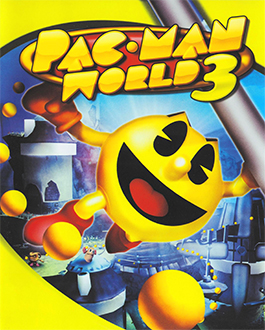
Pac-Man World 3 is a platform video game developed by Blitz Games and published by Namco for the PlayStation 2, GameCube, Xbox, PlayStation Portable, Nintendo DS, and Microsoft Windows. The Nintendo DS version was ported by Human Soft. Released in 2005, it is the third and final installment in the Pac-Man World trilogy and the only one to not be released in Japan. It also features a speaking Pac-Man for the first time ever outside of the cartoon series.

Pac-In-Time is a platform game developed by Atreid Concept featuring the arcade character Pac-Man. It was released in 1995 for MS-DOS, Macintosh, Super Nintendo Entertainment System, and Game Boy.
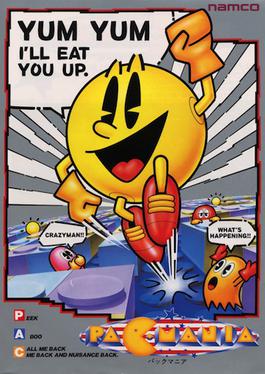
Pac-Mania is a cavalier perspective maze game that was developed and released by Namco for arcades in 1987. In the game, the player controls Pac-Man as he must eat all of the dots while avoiding the colored ghosts that chase him in the maze. Eating large flashing "Power Pellets" will allow Pac-Man to eat the ghosts for bonus points, which lasts for a short period of time. A new feature to this game allows Pac-Man to jump over the ghosts to evade capture. It is the ninth title in the Pac-Man video game series and was the last one developed for arcades up until the release of Pac-Man Arrangement in 1996. Development was directed by Pac-Man creator Toru Iwatani. It was licensed to Atari Games for release in North America.

Pac-Man and the Ghostly Adventures, also known in Japan as Pac-World, is an animated television series produced by 41 Entertainment, Arad Productions, a partnership between Sprite Animation Studios and OLM, Inc., and Bandai Namco Entertainment for Tokyo MX, BS11 and Disney XD. Based on Bandai Namco's Pac-Man video game franchise, it is the second animated series to be based upon the game franchise, following the 1982 TV series. The show aired from June 15, 2013, to May 25, 2015, running for two seasons and 52 episodes.
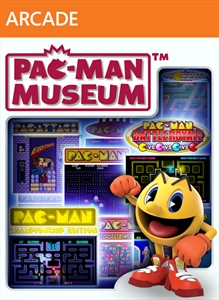
Pac-Man Museum is a 2014 compilation title developed and published by Bandai Namco Entertainment under the Namco label. It is a compilation of 9 Pac-Man games, with additional features such as achievements and online leaderboards.

Pac-Man 256 is an endless runner video game developed by Hipster Whale and 3 Sprockets and published by Bandai Namco Entertainment. The game is part of the Pac-Man series and is inspired by the original Pac-Man game's infamous Level 256 glitch. The game was originally released as a free-to-play title for iOS and Android on August 20, 2015. In June 21, 2016, Bandai Namco Studios Vancouver released a version of the game for the PlayStation 4, Xbox One, and PC, featuring additional features like multiplayer for up to 4 players, a new power-up, and no longer having to wait a certain amount of time to get power-ups, and instead having to eat a number of Pac-Dots.


















